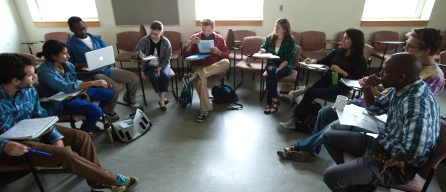The dictionary defines teaching as, “showing or explaining”, and explain in its simplest terms is “to make clear, make plain.” Making plain takes time and a dialogue to be sure each person within the exchange is in agreement, so with a class of 35 students and one teacher, one can come up with creative ways to “check for understanding”–hand signals, paper signs, random homework spot checks, all while moving forward at seeming breakneck pace, so none of their attention spans jumps away and the teacher no longer has a learning issue, but a management issue. For high achieving students, they can adapt to this environment quickly and be known for being a “good” student, who follows directions and shows their intelligence by turning in correct assignments on time–not creating any additional management issues (i.e. behavior problems) for a teacher. This can develop a certain relative anonymity in a 35 student classroom and large, 1000’s of student big high school.
So, when students write in their college essays, as they often do, that they’re seeking a smaller college that boasts a 1:20 professor to student ratio, so they can get individual attention, while they know the argument to make about the benefits of greater contact with their teachers, I wonder if they know what that means in reality.
And, for some, the contrast between their relative anonymity in a 35 student classroom, where the squeakiest wheel gets the grease, to being singled out daily multiple times in the class discussion, can be jolting, if not downright disquieting. Students accustomed to skating by on their ability comprehend quickly, without having to explain deeply their thinking, can be unknowingly surprised when they have to engage their peers and professors more than they’re accustomed. These can be the “good” challenges of college, and what students are ultimately seeking, but the transition to being around similarly smart and assertive students, when they’ve been used to be at the top of their class, can be awakening and humbling.
Understanding what a 1:20 student ratio looks and feels like in reality can be helpful for students that are just starting their college selection process. What would they need to do differently to prepare for class, if they knew the professor was going to select students at random to speak their opinion about the topic? How would they respond to criticism or disagreement with their position? What does “discussion-based” teaching method mean for the particular college? Given that many students are intimidated to talk with teachers, for fear of disrespecting their authority, how will the student engage the professors, even when they’re available in office hours to take advantage of the smaller student to professor ratio? Thinking through these questions or asking them on campus tours can help student choose colleges that fit their needs, as well as suit their learning style–especially in the face of continuing increases in tuition and other costs for college. The more thorough the search before applying, the more students and their families can be reasonably confident they’re gaining the value they seek from investing in a college degree.
Photo Credit: Middlebury College, Political Science Department




